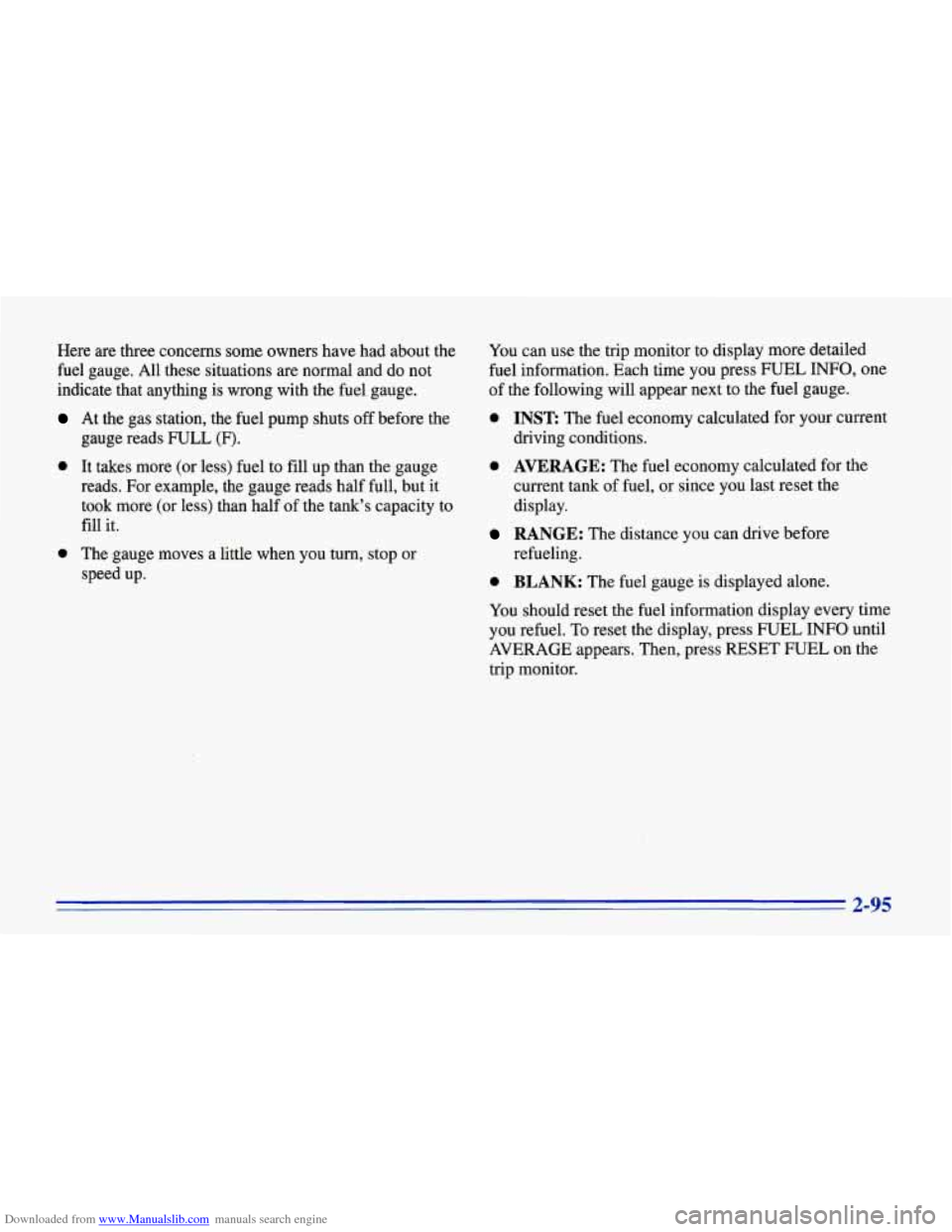Page 138 of 386

Downloaded from www.Manualslib.com manuals search engine Here are three concerns some owners have had about the
fuel gauge. All these situations are normal and do not
indicate that anything is wrong with the fuel gauge.
At the gas station, the fuel pump shuts off before the
gauge reads FULL (F).
0 It takes more (or less) fuel to fill up than the gauge
reads. For example,
the gauge reads half full, but it
took more (or less) than half of the tank’s capacity to
fill it.
0 The gauge moves a little when you turn, stop or
speed up. You
can use the trip monitor to display more detailed
fuel information. Each time you press FUEL
INFO, one
of the following will appear next to the fuel gauge.
0 INST: The fuel economy calculated for your current
driving conditions.
0 AVERAGE: The fuel economy calculated for the
current tank of fuel, or since you last reset the
display.
refueling.
RANGE: The distance you can drive before
0 BLANK: The fuel gauge is displayed alone.
You should reset the
fuel information display every time
you refuel. To reset the display, press FUEL
INFO until
AVERAGE appears. Then, press RESET FUEL on the
trip monitor.
2-95
Page 189 of 386

Downloaded from www.Manualslib.com manuals search engine Loading Your Vehicle
Tm OCCUPANTS VEHICLE CAP. WT.
TIRE-LOADING
INFORMATION
FRT. CTR. RR. TOTAL LBS. KG
MAX. LOADING & GVWR SAME AS VEHICLE
CAPACITY WEIGHT XXX COLD TIRE
TIRE
SIZE SPEED PRESSURE
RTG PSI/KPa
FRT.
RR.
SPA. IF TIRES ARE HOT, ADD 4PS1/28KPa
SEE OWNER‘S MANUAL FOR ADDITIONAL
INFORMATION
Two labels on your vehicle show how much weight it
may properly carry. The Tire-Loading Information label
found on the rear edge of the driver’s door tells you the
proper size, speed rating and recommended inflation.
It
also gives you important information about the number
of people that can be in your vehicle and the total weight
that you can carry. This weight is called Vehicle
Capacity Weight and includes the weight of all
occupants, cargo, and all nonfactory-installed options.
f I
MFD BY GENERAL MOTORS CORP
DATE GVWR GAWR FRT GAWR RR
THIS VEHICLE CONFORMS TO ALL APPLI-
CABLE
U.S. FEDERAL MOTOR VEHICLE
SAFETY, BUMPER, AND THEFT PREVENTION
STANDARDS
IN EFFECT ON THE DATE OF
MANUFACTURE SHOWN ABOVE.
The other label is the Certification label, found on the rear
edge of the driver’s door. It tells you the
gross weight
capacity of your vehicle, called the GVWR (Gross Vehicle
Weight Rating). The
GVWR includes the weight of the
vehicle, all occupants, fuel and cargo. Never exceed
the
GVWR for your vehicle, or the GAWR (Gross Axle
Weight Rating) for either the front or rear axle.
And, if you do have a heavy load, you should spread it
out. Don’t carry more than
100 pounds (45 kg) in your
rear area.
Page 242 of 386
Downloaded from www.Manualslib.com manuals search engine When to Add Oil
If the oil is at or below the ADD mark, you’ll need to
add some oil. But you must use the right kind. This part
explains what kind of oil to use.
For crankcase capacity,
see “Capacities and Specifications” in the Index.
NOTICE:
Don’t add too much oil. If your engine has so
much oil that the oil level gets above the upper
mark that shows the proper operating range,
your engine could be damaged.
The engine oil fill cap is on
top
of the engine block.
Just fill it enough to put the level somewhere in the
proper operating range. Push the dipstick all the way
back in when you’re through.
6-11
Page 283 of 386

Downloaded from www.Manualslib.com manuals search engine Grades B and A represent higher levels of performance
on the laboratory test wheel than the minimum required
by law.
Warning: The temperature grade for
this tire is
established for a tire that
is properly inflated and not
. overloaded. Excessive speed, underinflation, or
excessive loading, either separately
or in combination,
can cause heat buildup and possible tire failure.
Wheel Alignment and Tire Balance
The wheels on your vehicle were aligned and balanced
carefully at the factory to give you the longest tire life
and best overall performance.
In most cases, you will not need to have your wheels
aligned again. However, if you notice unusual tire wear
or your vehicle pulling one way or the other, the
alignment may need to be reset. If you notice your
vehicle vibrating when driving on a smooth road, your
wheels may need to be rebalanced.
Wheel Replacement
Replace any wheel that is bent, cracked, or badly rusted
or corroded. If wheel nuts keep coming loose, the wheel,
wheel bolts and wheel nuts should be replaced. If the
wheel leaks air, replace it (except some aluminum
wheels, which can sometimes be repaired). See your
Corvette dealer if any of these conditions exist.
Your dealer will know the kind of wheel you need.
,Each new wheel should have the same load-carrying
capacity, diameter, width, offset and be mounted the
same way as the one it replaces.
If you need to replace any of your wheels, wheel bolts
or wheel nuts, replace them only with new
GM original
equipment parts.
This way, you will be sure to have the
right wheel, wheel bolts and wheel nuts for your
Corvette model.
6-52